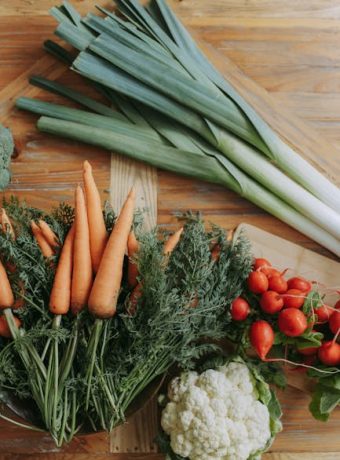Winter Vegetables: Comforting Stews and Soups
As the temperature drops and the days grow shorter, there’s nothing more comforting than a warm bowl of stew or soup made from hearty winter vegetables. Not only are these dishes soul-warming, but they are also packed with nutrients that support your health during the colder months.
In this blog post, we will explore the best winter vegetables to use in your stews and soups, share some mouth-watering recipes, and provide tips on how to make the most of these seasonal ingredients. So, grab your favorite ladle and let’s dive into the world of winter vegetable stews and soups!
The Best Winter Vegetables for Stews and Soups
Winter vegetables are known for their robust flavors and nutrient density. Here are some of the best options to include in your comforting winter stews and soups:
1. Root Vegetables
Root vegetables like carrots, parsnips, and turnips are excellent choices for stews and soups. They are rich in vitamins A and C, fiber, and antioxidants, which help boost your immune system. Additionally, their natural sweetness enhances the flavor of your dishes.
2. Squash
Butternut squash, acorn squash, and pumpkin are all fantastic additions to winter soups and stews. These vegetables are high in beta-carotene, which the body converts into vitamin A, supporting vision and immune health. Their creamy texture makes them perfect for pureeing into smooth, velvety soups.
3. Cruciferous Vegetables
Cruciferous vegetables such as cabbage, kale, and Brussels sprouts are packed with vitamins C and K, as well as folate and fiber. These vegetables add a unique flavor and texture to your dishes, and their high nutrient content helps keep you healthy during the winter.
4. Potatoes and Sweet Potatoes
Potatoes and sweet potatoes are staple ingredients in many winter stews and soups. They provide a good source of carbohydrates for energy, as well as vitamins B6 and C, potassium, and fiber. Sweet potatoes, in particular, are rich in antioxidants and have a naturally sweet flavor that pairs well with savory ingredients.
Mouth-Watering Winter Stew and Soup Recipes
Now that we’ve covered some of the best winter vegetables for stews and soups, let’s dive into some delicious recipes that will keep you warm and satisfied all season long.
1. Hearty Vegetable Stew
This hearty vegetable stew is a perfect way to showcase the flavors of winter vegetables. Here’s what you’ll need:
- 2 tablespoons olive oil
- 1 onion, chopped
- 2 cloves garlic, minced
- 3 carrots, peeled and chopped
- 2 parsnips, peeled and chopped
- 1 turnip, peeled and chopped
- 2 potatoes, peeled and chopped
- 1 cup chopped cabbage
- 1 can (14.5 ounces) diced tomatoes
- 4 cups vegetable broth
- 1 teaspoon dried thyme
- 1 bay leaf
- Salt and pepper to taste
Instructions:
- Heat the olive oil in a large pot over medium heat. Add the onion and garlic, and cook until softened, about 5 minutes.
- Add the carrots, parsnips, turnip, potatoes, and cabbage. Cook for another 5 minutes, stirring occasionally.
- Add the diced tomatoes, vegetable broth, thyme, and bay leaf. Bring to a boil, then reduce the heat and simmer for 30-40 minutes, or until the vegetables are tender.
- Season with salt and pepper to taste. Remove the bay leaf before serving.
2. Creamy Butternut Squash Soup
This creamy butternut squash soup is both comforting and nutritious. Here’s what you’ll need:
- 2 tablespoons butter
- 1 onion, chopped
- 2 cloves garlic, minced
- 1 butternut squash, peeled, seeded, and cubed
- 4 cups chicken or vegetable broth
- 1/2 cup heavy cream (optional)
- Salt and pepper to taste
- Fresh sage or thyme for garnish
Instructions:
- In a large pot, melt the butter over medium heat. Add the onion and garlic, and cook until softened, about 5 minutes.
- Add the butternut squash and broth. Bring to a boil, then reduce the heat and simmer for 20-25 minutes, or until the squash is tender.
- Using an immersion blender, puree the soup until smooth. Alternatively, you can transfer the soup to a blender in batches and blend until smooth.
- Stir in the heavy cream, if using, and season with salt and pepper to taste.
- Garnish with fresh sage or thyme before serving.
3. Kale and White Bean Soup
This nutritious kale and white bean soup is perfect for a cold winter day. Here’s what you’ll need:
- 2 tablespoons olive oil
- 1 onion, chopped
- 2 cloves garlic, minced
- 3 carrots, peeled and chopped
- 1 can (14.5 ounces) diced tomatoes
- 4 cups vegetable broth
- 1 can (15 ounces) white beans, drained and rinsed
- 1 bunch kale, stems removed and leaves chopped
- 1 teaspoon dried thyme
- Salt and pepper to taste
Instructions:
- Heat the olive oil in a large pot over medium heat. Add the onion and garlic, and cook until softened, about 5 minutes.
- Add the carrots and cook for another 5 minutes, stirring occasionally.
- Add the diced tomatoes, vegetable broth, and white beans. Bring to a boil, then reduce the heat and simmer for 20 minutes.
- Add the chopped kale and thyme. Cook for another 10 minutes, or until the kale is tender.
- Season with salt and pepper to taste before serving.
Tips for Making the Perfect Winter Stew or Soup
Creating the perfect winter stew or soup involves more than just throwing ingredients into a pot. Here are some tips to help you make the most of your winter vegetables:
1. Use Fresh, Seasonal Ingredients
Whenever possible, use fresh, seasonal vegetables. Winter vegetables are at their peak flavor and nutritional value during the colder months, making them the best choice for your stews and soups.
2. Layer Your Flavors
Start by sautéing aromatics like onions, garlic, and celery to build a flavorful base. Then, add your vegetables and cook them for a few minutes before adding liquids like broth or tomatoes. This layering technique helps develop a richer, more complex flavor.
3. Don’t Overcook the Vegetables
While it’s important to cook your vegetables until they’re tender, be careful not to overcook them. Overcooked vegetables can become mushy and lose their texture. Aim for a balance where the vegetables are soft but still hold their shape.
4. Season as You Go
Season your stew or soup throughout the cooking process, rather than just at the end. This allows the flavors to meld together and ensures a well-seasoned final dish.
5. Add Fresh Herbs and Greens at the End
Fresh herbs and greens like parsley, cilantro, spinach, and kale should be added towards the end of cooking to preserve their bright flavors and vibrant colors.
Conclusion
Winter vegetable stews and soups are not only comforting and delicious, but they are also a fantastic way to incorporate nutrient-rich seasonal produce into your diet. By using the best winter vegetables and following our tips and recipes, you can create hearty dishes that will keep you warm and satisfied all season long.
So, next time you’re looking for a cozy meal to enjoy by the fire, reach for those winter vegetables and whip up a comforting stew or soup. Your taste buds and your body will thank you!



